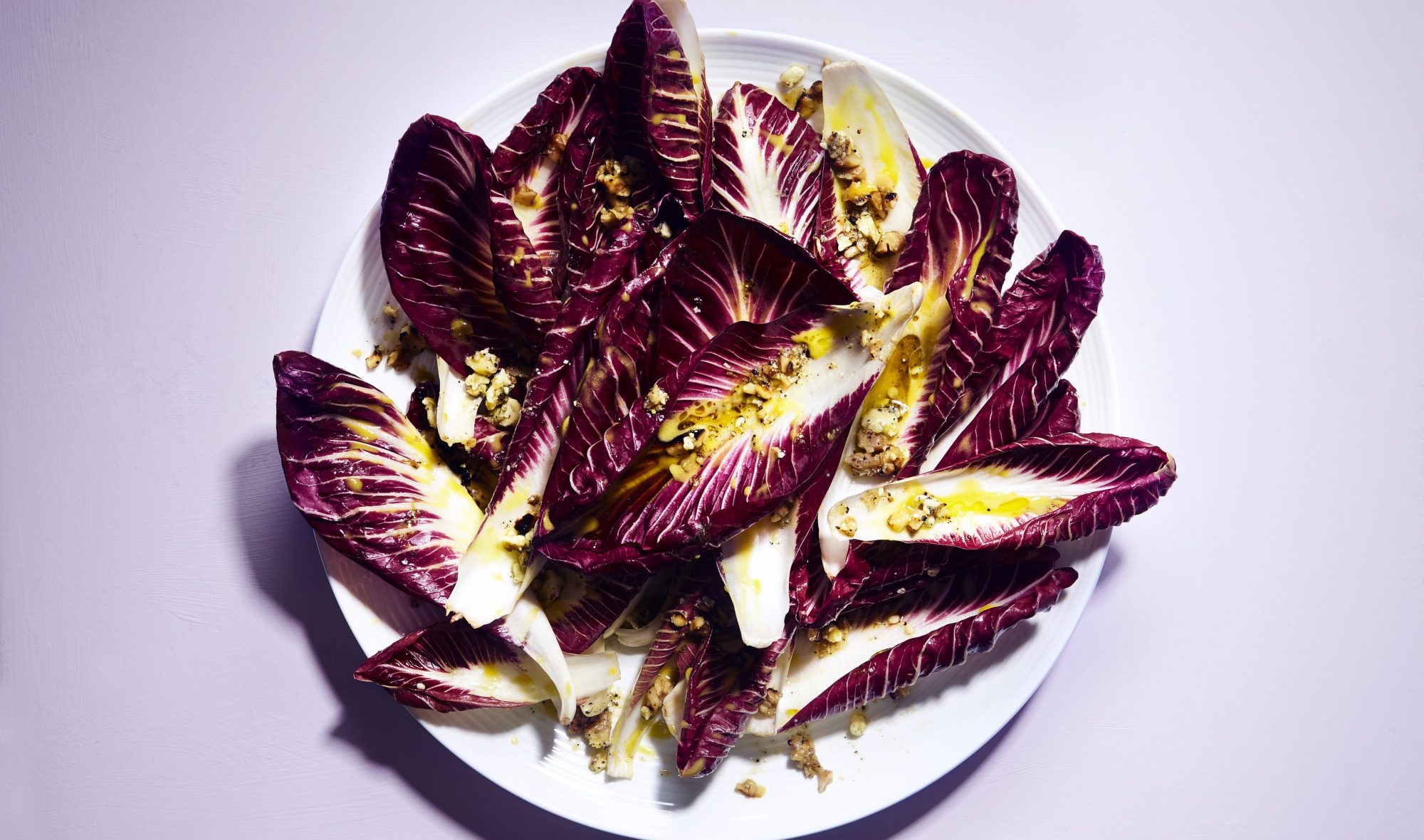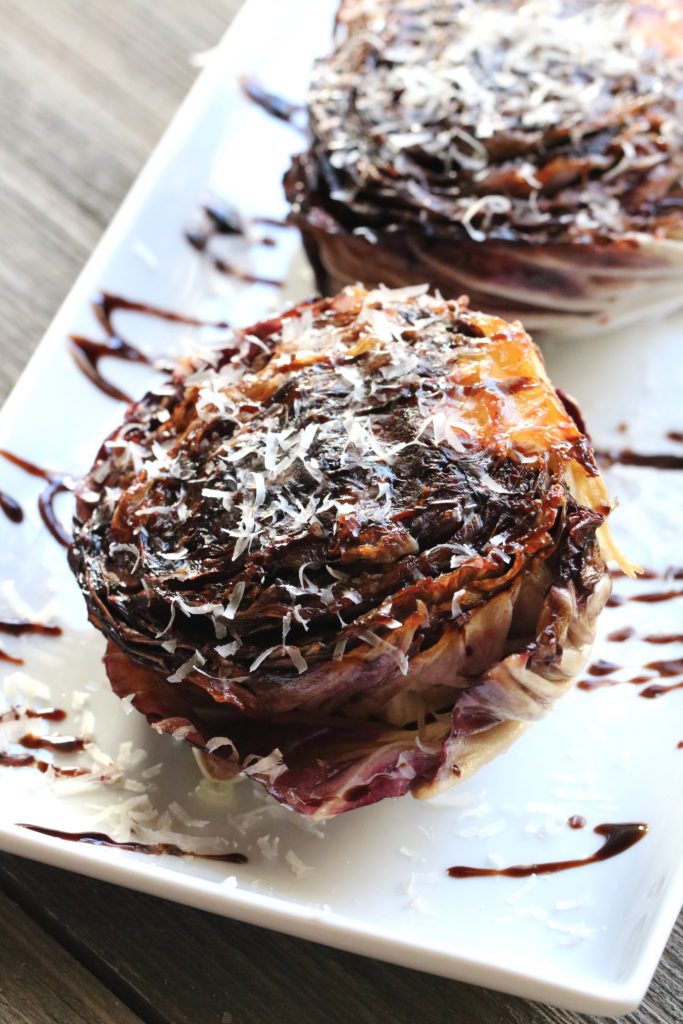
💥 SAVE 54% on the PN Nutrition Certification + Coaching Career Kickstarter Course! Ends Friday.

💥 SAVE 54% on the PN Nutrition Certification + Coaching Career Kickstarter Course!

Radicchio is a flamboyant wine-colored member of the chicory family. It is related to Belgian endives and has a similar bitter, slightly spicy, refreshing taste. Radicchio was first cultivated in Italy, and the two main cultivars you are likely to find in stores, Chioggia and Treviso, are named after the Italian cities from which they originate. Radicchio is a cool-weather crop and is in season late winter and early spring. Like most leafy vegetables, it is very low in calories per volume, but it is an excellent source of vitamin K and folate. Radicchio is also a good source of zeaxanthin, a carotenoid pigment in the vitamin A family that is good for eye health. Like most Italian words, saying its name will make you feel cultured and romantic. In case you’re wondering, it’s pronounced rah-DEE-kee-oh.
Radicchio (pronounced rah-DEE-kee-oh) is a flamboyant wine-colored member of the chicory family. It is related to Belgian endives and has a similar bitter, slightly spicy taste.
As you may deduce from its name, radicchio has Italian roots, and in fact, is sometimes called Italian chicory.
Radicchio was first cultivated in the fifteenth century in Italy, and today, the two main varieties we see in stores are named after their Italian cities of origin. There is the Chioggia variety, which is round and about the size of a grapefruit, and there is the Treviso variety, which is an elongated version that looks like a purple Belgian endive.
Like Belgian endives, radicchio also has a complex cultivation process. First, it is grown outdoors. Its leafy head is then harvested and the outer green leaves are plucked off to reveal the stark contrast of white veining on deep purple leaves. These delicate heads are then stored in temperature- and humidity-controlled rooms, where they are left to mature in complete darkness. If they were exposed to light, chlorophyll would be triggered and the outer leaves would turn green.
Radicchio grows best in cool weather. A chilly temperature helps them to develop their best flavor and most vibrant color.
Radicchio is found in two main varieties: Chioggia and Treviso.
Both varieties have delicately crispy leaves with a slightly bitter, spicy taste, similar to endives. Their texture is slightly heartier than most lettuces, making them suitable for grilling. The base of their leaves is white, which veins into a rich eggplant color.
The Chioggia variety is round and squat and about the size of a grapefruit, appearing like a small, loosely packed red cabbage. The Verona variety is elongated and has a slightly more robust bitter taste.
Two cups of shredded radicchio (about 80.0g) has 18 calories, 1.2g protein, 3.6g of carbohydrates, 0.8g fiber, 0.5g sugar, and no fat. Radicchio is an excellent source of vitamin K and a good source of folate.
Radicchio is also a good source of zeaxanthin, a carotenoid pigment in the vitamin A family that is good for eye health. Interestingly, radicchio also contains lactucopicrin (also known as intybin), a bitter compound that has sedative and analgesic (painkilling) effects.
Radicchio is available at most good grocery stores and fresh produce markets, particularly in late winter and early spring.
Good quality, fresh radicchio will have firm heads with tightly-packed leaves. Colors should be vibrant. Pass over specimens that show signs of wilting, darkening, or holes from nibbling pests.
Radicchio is best preserved wrapped in plastic and stored in the fridge. Stored thusly, it will stay fresh for up to a week.
If a little bit of wilting occurs, radicchio can be revived by chopping it up and immersing it in a bowl of cold water for about half an hour, during which time it should crisp up again.
Radicchio is delicious sautéed or even grilled, but the simplest way to eat it is raw.
To prepare radicchio, first, chop the last centimeter off the coarse butt. Slice the radicchio in half, lengthwise, and then you may cut out a wedge at the bottom, where the leaves have fused together to form a solid white heart. This part is quite bitter, although completely edible, so it is your choice whether you remove it or not. Then, you can either separate whole leaves from the head to be used as cups to hold taco or sandwich fillings, or you can slice the leaves into thin ribbons and mix into a salad. To wash, place the chopped radicchio in a strainer or rinse the whole leaves under cool water. Dress with your choice of dressing or toppings, and eat!

The sweetness from the honey and cinnamon and savory Parmesan cheese really help balance the naturally bitter flavor of radicchio – finally, a bitter vegetable you can enjoy!
Prep Time: 2 minutes Cook Time: 9 minutes Yield: 4 servings
Heat the grill or grill plate to low. If using a grill plate, drizzle with a little olive oil.
Next, mix 2 tbsp olive oil, 2 tbsp honey, 1 tsp balsamic vinegar, and ¼ tsp cinnamon in a small bowl.
Cut radicchio in half lengthwise (do this right before you want to grill it otherwise it will start to brown).
Brush the mixture over both sides of the radicchio – ensuring you pick up some of the thick honey which will often settle at the bottom of the bowl – and place face down on the grill/grill plate. Grill for approximately 6 to 7 minutes on a grill plate, or 3 to 4 minutes on a grill. Then turn the grill to medium-high, flip the radicchio over, and grill for 1 to 2 minutes more, until soft all the way through, but not charred.
Finally, drizzle a bit more balsamic (approximately ½ tsp on each radicchio half) and sprinkle grated Parmesan evenly over all 4 halves.
Enjoy!
Precision Nutrition’s Encyclopedia of Food expands every single month as we highlight new foods and showcase beautiful food photography. If you’d like to stay up to date, simply click this link. From there, we’ll send you a FREE copy of our recipe book. We’ll also let you know when new and delicious foods are added to the site.
Radicchio is a flamboyant wine-colored member of the chicory family. It is related to Belgian endives and has a similar bitter, slightly spicy, refreshing taste. Radicchio was first cultivated in Italy, and the two main cultivars you are likely to find in stores, Chioggia and Treviso, are named after the Italian cities from which they originate. Radicchio is a cool-weather crop and is in season late winter and early spring. Like most leafy vegetables, it is very low in calories per volume, but it is an excellent source of vitamin K and folate. Radicchio is also a good source of zeaxanthin, a carotenoid pigment in the vitamin A family that is good for eye health. Like most Italian words, saying its name will make you feel cultured and romantic. In case you’re wondering, it’s pronounced rah-DEE-kee-oh.